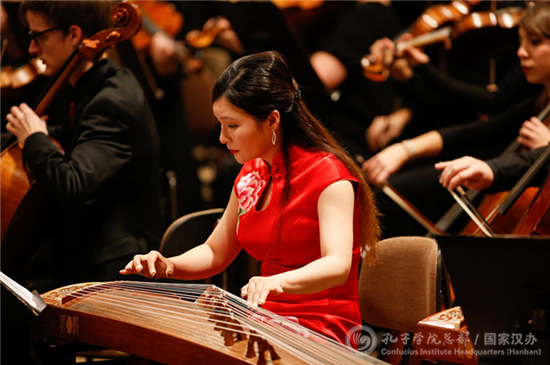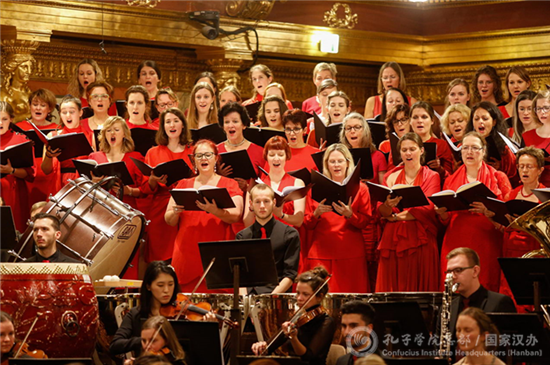Large-scale Symphonic Choral Concert ¡°Chang'An Men¡± Performed on the Stage of Vienna Golden Hall
On December 11th local time, the large-scale symphonic choral concert ¡°Chang'An Men¡±, hosted by the University of Vienna in Austria and co-organized by its Confucius Institute, was performed on the stage of Vienna Golden Hall. This concert was performed jointly by China National Symphony Orchestra and the choir of the University of Vienna, with Daniel Schostok, an Austrian tenor, Cai Yayi, Chinese artist of traditional Nanyin and Ji Wei, a Chinese guzheng performer included in its list of performers. Government officials of Austria, representatives from the Chinese Embassy in Austria and relevant staff of the University of Vienna attended the concert.

Live performance
Composed by famous Indian composer Vijay Upadhyaya, ¡°Chang'An Men¡± was produced with Belt and Road Initiative as its theme. It took its listeners to a journey to appreciate histories and cultures of different Chinese dynasties. Vijay Upadhyaya assimilated techniques of western symphony and chorus as well as traditional Chinese music, literature and philosophic ideology into this work. In the tradition of Chinese vocality which spans several thousand years, the melody is created based on the tone of language. Such unique tradition has, for decades, been ignored and never been used in symphony. ¡°Chang'An Men¡± tried to pick up such unique tradition and endowed language with the greatest significance. Conforming to the language model strictly, Vijiay Upadhyaya, for the first time, combined traditional Chinese chant, language with music and harmony to create a new style of counterpoint.

Conductor

Guzheng performance

Choir

Symphony orchestra
¡°Chang'An Men¡± consists of four movements. Adopting original texts in the Analects of Confucius, the work of Chinese philosopher Confucius, the first movement expresses five virtues valued by Confucius, namely, Benevolence, Righteousness, Manner, Wisdom and Fidelity. Austrian tenor Daniel Schostok sang, instead of reading, the texts out, which contrasted sharply to radical symphony. Based on the Book of Songs, the second movement adheres to original rhythm of the poems and uses rhythmical instruments accompanied by vocality and harmony, expressing ancient people¡¯s desire for freedom. The third movement is based on a song of Nanyin style ¡°Departing for the Frontier¡±, originated from Fujian Province. As a traditional Chinese singing style, Nanyin was spread to Italy through the Silk Road and then leaded to the appearance of vibrato during the development history of western vocality. Cai Yayi, a Chinese artist of traditional Nanyin offered an extremely terrific performance for the audience. The concept of the fourth movement comes from Tao Te Ching, the work of the great Chinese philosopher Lao Tzu. Centering on the theme of ¡°Tao¡±, the fourth movement conveys the ideas of the composer, that is, harmony and inclusiveness. Based on the Analects of Confucius again, the last movement, through music, describes turmoil and conflict of today¡¯s society and people¡¯s desire for peace and tranquility.

Performance curtain call

Group photo
No empty seats were left for the concert. The symphony was magnificent, with artist of Nanyin singing in pleasant manner. The clash and blend of Chinese and Western music offered new and terrific performance for audience to appreciate. The applause lasted for a long time even after its conclusion.
Story by Chen Sining; photos by China National Symphony Orchestra
Related News

